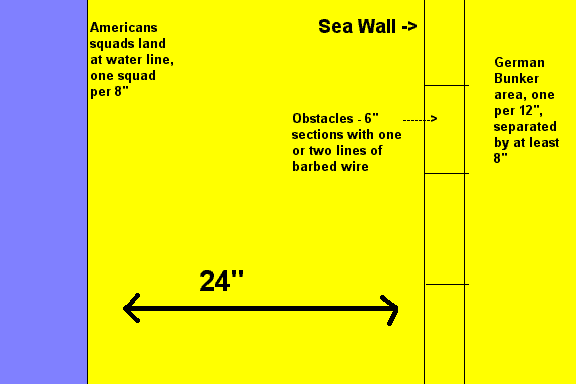 Turn Sequence
Turn Sequence
1. Beach Landings
2. Americans Move, Clear Obstacles, or Assault Bunkers
3. Germans Shoot
4. German Artillery
5. American Morale Tests
Beach Landings
American landing craft are placed at the water line and the figures in the landing craft are placed on the beach in front of the craft. On turn one all the American squads will arrive in this manner, after that squads will land only as replacements for a squad that has been destroyed (failed a morale test last turn). In my battles there is usually no limit to how many replacements can land. If you want to give the Germans a chance to win you can limit the number of replacements. If you have a limit you can place a red penny or other marker down whenever a squad is eliminated to help you keep track of how many squads have landed on the beach. The landing craft have no effect on play (they can't be shot at or hit by artillery), they serve only as holding trays for American casualties.
Americans Move, Clear Obstacles, or Assault Bunkers American players may choose ONE action for each figure in their command:
Americans Move
Figures move up to 6". Figures must stop at the sea wall. They may only move past the sea wall in later turns if any obstacles in the way have been cleared.
Clear Obstacles
Any American figures that start the turn at the sea wall may attempt to clear the obstacles in their way. Roll 1 D6 for each figure attempting this. Every 6 rolled will clear one obstacle. This represents using wire cutters, and bangalore torpedoes to clear barbed wire, and mine detectors to find a path through mine fields. Figures may not move through a gap created in the obstacles on the same turn the gap is created.
Assault
American figures that start the turn in contact with a German bunker may attempt to assault it. Roll a D6 for each figure attempting to assault. A roll of 6 on any die will destroy the bunker. This represents attacking German positions with flamethrowers, demolitions, grenades, and small arms.
Germans Shoot
Every surviving German bunker may fire at an American squad. The German player will roll 4 D6 for each bunker and an American figure will be hit for every 5 or 6 rolled. The casualties should be tipped over, not removed, until the morale tests are done.
German Artillery
The German players get to throw two cotton balls for each bunker (including destroyed bunkers). Each represents a mortar or artillery shell. The players must stand an arm's length away from their table edge, then they throw the balls onto the battlefield. Continue throwing the balls until all of them have been used. It doesn't matter if they bounce or roll, their final resting place is all that counts. If some of the balls end up off the table that's too bad, those shells went astray. When all the balls have been thrown the damage is assessed. Any cotton balls that end up on the German side of the sea wall are considered misses, they should be removed. Any figure that is touching a cotton ball, or whose base is under a ball is removed. When in doubt remove the figure.
Morale
American squads that have taken casualties this turn must check morale. Roll a D6 for every figure lost THIS turn. If the total is 12 or more the squad has been eleminated as a fighting force. The American player should place all the figures (including casualties) back in the landing craft and land them as a fresh squad during the Beach Landings phase of the next turn. If the total is less than 12 there is no effect on the squad. Remove the figures that were eliminated this turn, the remainder of the squad can fight on next turn.
Map

Get off the Beach D-Day Normandy Invasion
- Historical Background and Set Up
Fast Play Rules for Students
Paper Soldiers and D-Day (very slow: 282K)
Back to Table of Contents -- Junior General Report # 4
Back to Junior General Report List of Issues
Back to MagWeb.com Magazine List
© Copyright 2004 by Matt Fritz.
This article appears in MagWeb.com (Magazine Web) on the Internet World Wide Web. Other articles covering military history and related topics are available at http://www.magweb.com